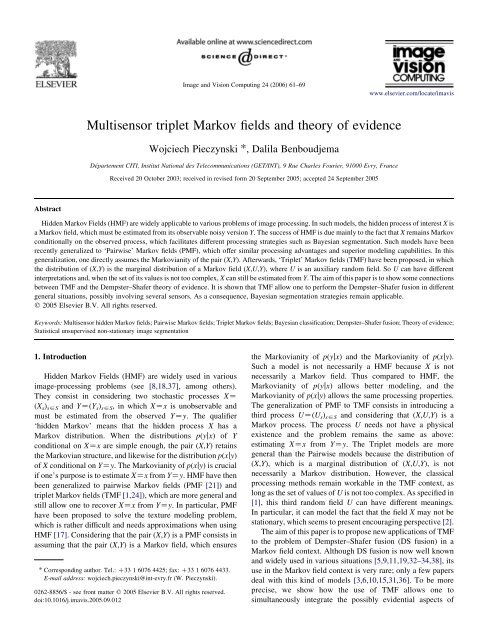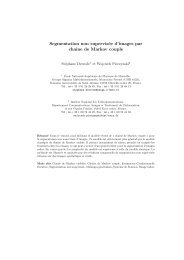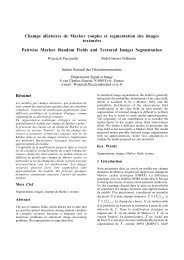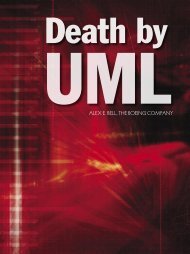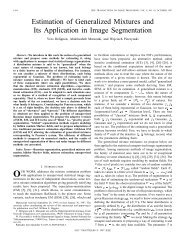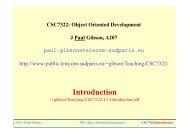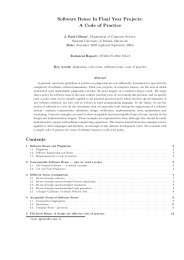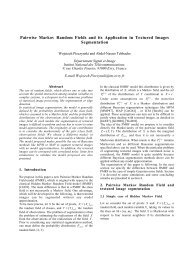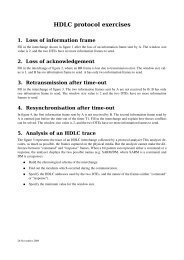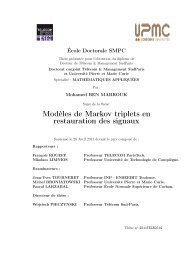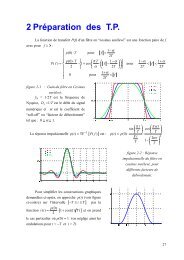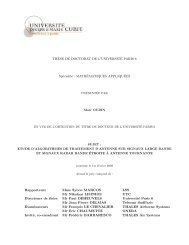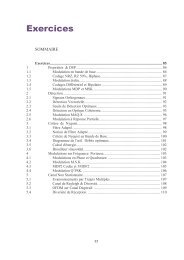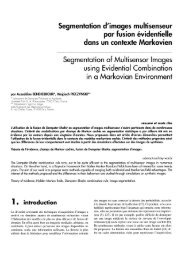Multisensor triplet Markov fields and theory of evidence
Multisensor triplet Markov fields and theory of evidence
Multisensor triplet Markov fields and theory of evidence
You also want an ePaper? Increase the reach of your titles
YUMPU automatically turns print PDFs into web optimized ePapers that Google loves.
Image <strong>and</strong> Vision Computing 24 (2006) 61–69<br />
www.elsevier.com/locate/imavis<br />
<strong>Multisensor</strong> <strong>triplet</strong> <strong>Markov</strong> <strong>fields</strong> <strong>and</strong> <strong>theory</strong> <strong>of</strong> <strong>evidence</strong><br />
Wojciech Pieczynski *, Dalila Benboudjema<br />
Département CITI, Institut National des Telecommunications (GET/INT), 9 Rue Charles Fourier, 91000 Evry, France<br />
Received 20 October 2003; received in revised form 20 September 2005; accepted 24 September 2005<br />
Abstract<br />
Hidden <strong>Markov</strong> Fields (HMF) are widely applicable to various problems <strong>of</strong> image processing. In such models, the hidden process <strong>of</strong> interest X is<br />
a <strong>Markov</strong> field, which must be estimated from its observable noisy version Y. The success <strong>of</strong> HMF is due mainly to the fact that X remains <strong>Markov</strong><br />
conditionally on the observed process, which facilitates different processing strategies such as Bayesian segmentation. Such models have been<br />
recently generalized to ‘Pairwise’ <strong>Markov</strong> <strong>fields</strong> (PMF), which <strong>of</strong>fer similar processing advantages <strong>and</strong> superior modeling capabilities. In this<br />
generalization, one directly assumes the <strong>Markov</strong>ianity <strong>of</strong> the pair (X,Y). Afterwards, ‘Triplet’ <strong>Markov</strong> <strong>fields</strong> (TMF) have been proposed, in which<br />
the distribution <strong>of</strong> (X,Y) is the marginal distribution <strong>of</strong> a <strong>Markov</strong> field (X,U,Y), where U is an auxiliary r<strong>and</strong>om field. So U can have different<br />
interpretations <strong>and</strong>, when the set <strong>of</strong> its values is not too complex, X can still be estimated from Y. The aim <strong>of</strong> this paper is to show some connections<br />
between TMF <strong>and</strong> the Dempster–Shafer <strong>theory</strong> <strong>of</strong> <strong>evidence</strong>. It is shown that TMF allow one to perform the Dempster–Shafer fusion in different<br />
general situations, possibly involving several sensors. As a consequence, Bayesian segmentation strategies remain applicable.<br />
q 2005 Elsevier B.V. All rights reserved.<br />
Keywords: <strong>Multisensor</strong> hidden <strong>Markov</strong> <strong>fields</strong>; Pairwise <strong>Markov</strong> <strong>fields</strong>; Triplet <strong>Markov</strong> <strong>fields</strong>; Bayesian classification; Dempster–Shafer fusion; Theory <strong>of</strong> <strong>evidence</strong>;<br />
Statistical unsupervised non-stationary image segmentation<br />
1. Introduction<br />
Hidden <strong>Markov</strong> Fields (HMF) are widely used in various<br />
image-processing problems (see [8,18,37], among others).<br />
They consist in considering two stochastic processes XZ<br />
(X s ) s2S <strong>and</strong> YZ(Y s ) s2S , in which XZx is unobservable <strong>and</strong><br />
must be estimated from the observed YZy. The qualifier<br />
‘hidden <strong>Markov</strong>’ means that the hidden process X has a<br />
<strong>Markov</strong> distribution. When the distributions p(yjx) <strong>of</strong> Y<br />
conditional on XZx are simple enough, the pair (X,Y) retains<br />
the <strong>Markov</strong>ian structure, <strong>and</strong> likewise for the distribution p(xjy)<br />
<strong>of</strong> X conditional on YZy. The <strong>Markov</strong>ianity <strong>of</strong> p(xjy) is crucial<br />
if one’s purpose is to estimate XZx from YZy. HMF have then<br />
been generalized to pairwise <strong>Markov</strong> <strong>fields</strong> (PMF [21]) <strong>and</strong><br />
<strong>triplet</strong> <strong>Markov</strong> <strong>fields</strong> (TMF [1,24]), which are more general <strong>and</strong><br />
still allow one to recover XZx from YZy. In particular, PMF<br />
have been proposed to solve the texture modeling problem,<br />
which is rather difficult <strong>and</strong> needs approximations when using<br />
HMF [17]. Considering that the pair (X,Y) is a PMF consists in<br />
assuming that the pair (X,Y) is a <strong>Markov</strong> field, which ensures<br />
* Corresponding author. Tel.: C33 1 6076 4425; fax: C33 1 6076 4433.<br />
E-mail address: wojciech.pieczynski@int-evry.fr (W. Pieczynski).<br />
0262-8856/$ - see front matter q 2005 Elsevier B.V. All rights reserved.<br />
doi:10.1016/j.imavis.2005.09.012<br />
the <strong>Markov</strong>ianity <strong>of</strong> p(yjx) <strong>and</strong> the <strong>Markov</strong>ianity <strong>of</strong> p(xjy).<br />
Such a model is not necessarily a HMF because X is not<br />
necessarily a <strong>Markov</strong> field. Thus compared to HMF, the<br />
<strong>Markov</strong>ianity <strong>of</strong> p(yjx) allows better modeling, <strong>and</strong> the<br />
<strong>Markov</strong>ianity <strong>of</strong> p(xjy) allows the same processing properties.<br />
The generalization <strong>of</strong> PMF to TMF consists in introducing a<br />
third process UZ(U s ) s2S <strong>and</strong> considering that (X,U,Y) isa<br />
<strong>Markov</strong> process. The process U needs not have a physical<br />
existence <strong>and</strong> the problem remains the same as above:<br />
estimating XZx from YZy. The Triplet models are more<br />
general than the Pairwise models because the distribution <strong>of</strong><br />
(X,Y), which is a marginal distribution <strong>of</strong> (X,U,Y), is not<br />
necessarily a <strong>Markov</strong> distribution. However, the classical<br />
processing methods remain workable in the TMF context, as<br />
long as the set <strong>of</strong> values <strong>of</strong> U is not too complex. As specified in<br />
[1], this third r<strong>and</strong>om field U can have different meanings.<br />
In particular, it can model the fact that the field X may not be<br />
stationary, which seems to present encouraging perspective [2].<br />
The aim <strong>of</strong> this paper is to propose new applications <strong>of</strong> TMF<br />
to the problem <strong>of</strong> Dempster–Shafer fusion (DS fusion) in a<br />
<strong>Markov</strong> field context. Although DS fusion is now well known<br />
<strong>and</strong> widely used in various situations [5,9,11,19,32–34,38], its<br />
use in the <strong>Markov</strong> field context is very rare; only a few papers<br />
deal with this kind <strong>of</strong> models [3,6,10,15,31,36]. To be more<br />
precise, we show how the use <strong>of</strong> TMF allows one to<br />
simultaneously integrate the possibly evidential aspects <strong>of</strong>
62<br />
W. Pieczynski, D. Benboudjema / Image <strong>and</strong> Vision Computing 24 (2006) 61–69<br />
the prior information <strong>and</strong> the possibly evidential aspects <strong>of</strong> the<br />
sensors. The first integration can be <strong>of</strong> interest when the hidden<br />
scene is non-stationary, <strong>and</strong> the second one enables one to<br />
extend different classical multisensor images analysis (see<br />
[14,29,35], among others).<br />
Let us mention that similar extensions have been proposed<br />
in the case <strong>of</strong> <strong>Markov</strong> chains. In fact, hidden <strong>Markov</strong> chains<br />
(HMC) have been generalized to pairwise <strong>Markov</strong> chains<br />
(PMC [23]), <strong>and</strong> <strong>triplet</strong> <strong>Markov</strong> chains (TMC [25]). In<br />
particular, evidential priors have been introduced in HMC<br />
[7,28], resulting in an improvement in the efficiency <strong>of</strong> the<br />
unsupervised segmentation <strong>of</strong> non-stationary chains [12].<br />
Moreover, still more complex models, including partially<br />
<strong>Markov</strong> chains or semi-<strong>Markov</strong> chains, have been recently<br />
proposed in [26,27]. All these models can be possibly extended<br />
to <strong>Markov</strong> trees, <strong>and</strong> some first ideas are presented in [13].<br />
However, although these very general ideas have inspired the<br />
main ideas <strong>of</strong> the present paper, the <strong>Markov</strong> field models—<strong>and</strong><br />
the related problems such as, for instance, parameter<br />
estimation—are very different from the <strong>Markov</strong> chain models<br />
<strong>and</strong> the related problems. Therefore, below we will concentrate<br />
on <strong>Markov</strong> <strong>fields</strong> with no further consideration <strong>of</strong> <strong>Markov</strong><br />
chains.<br />
The organization <strong>of</strong> the paper is as follows. The basic<br />
notions <strong>and</strong> calculations relating to the <strong>theory</strong> <strong>of</strong> <strong>evidence</strong> are<br />
recalled in Section 2, while Section 3 is devoted to the<br />
introduction <strong>of</strong> evidential priors in the context <strong>of</strong> <strong>Markov</strong><br />
<strong>fields</strong>. The use <strong>of</strong> evidential sensors is discussed in Section 4,<br />
<strong>and</strong> the general model, including evidential priors <strong>and</strong><br />
evidential sensors, is specified in Section 5. Section 6 contains<br />
conclusions <strong>and</strong> some future prospects.<br />
2. Theory <strong>of</strong> <strong>evidence</strong><br />
Let us consider a finite set <strong>of</strong> classes UZ{u 1 ,.u k }, <strong>and</strong> its<br />
power set P(U)Z{A 1 ,.A q }, with qZ2 k . A function M from<br />
P(U) to [0,1] is called a ‘basic belief assignment’ (bba) if<br />
M(:)Z0 <strong>and</strong> P A2PðUÞ MðAÞZ1. A bba M defines a<br />
‘plausibility’ function Pl from P(U) to [0,1] by<br />
PlðAÞZ P AhBs: MðBÞ, <strong>and</strong> a ‘credibility’ function Cr from<br />
P(U) to [0,1] by CrðAÞZ P B3A MðBÞ. For a given bba M, the<br />
corresponding plausibility function Pl <strong>and</strong> credibility function<br />
Cr are linked by Pl(A)CCr(A c )Z1. So, each <strong>of</strong> them<br />
defines the other. Conversely, Pl <strong>and</strong> Cr can be defined<br />
by some axioms, <strong>and</strong> each <strong>of</strong> them defines an unique<br />
corresponding bba M. More precisely, Cr is a function<br />
from P(U) to [0,1] verifying Cr(:)Z0, Cr(U)Z1, <strong>and</strong><br />
Cr g j2J A j<br />
<br />
R<br />
PIs: I3J ðK1ÞjIjC1 Cr h j2I A j<br />
<br />
, <strong>and</strong> Pl is a function<br />
from P(U) to [0,1] verifying analogous conditions, with %<br />
instead <strong>of</strong> R in the third one. A credibility function Cr<br />
verifying such conditions is also the credibility function<br />
defined by the bba MðAÞZ P B3A ðK1Þ jAKBj CrðBÞ.<br />
Finally, each <strong>of</strong> the three functions M, Pl, <strong>and</strong> Cr can be<br />
defined in an axiomatic way, <strong>and</strong> each <strong>of</strong> them defines the two<br />
others. Furthermore, when M is null outside singletons, the<br />
corresponding Pl <strong>and</strong> Cr are equal <strong>and</strong> become a classical<br />
probability. Thus a probability is obtained for a particular M,<br />
which will be called ‘probabilistic’ in the following.<br />
When two bbas M 1 , M 2 represent two pieces <strong>of</strong> <strong>evidence</strong>, we<br />
can combine—or fuse—them using the so-called ‘Dempster–<br />
Shafer combination rule’, or ‘Dempster–Shafer fusion’ (DS<br />
fusion) which gives MZM 1 4M 2 defined by:<br />
MðAÞ Z ðM 1 4M 2 ÞðAÞ<br />
8<br />
1 X<br />
><<br />
M<br />
Z 1KH<br />
1 ðB 1 ÞM 2 ðB 2 Þ; for As:;<br />
ðB 1 ;B 2 Þ2U 2 =B 1 hB 2 ZA<br />
>:<br />
0; for A Z :<br />
(2.1)<br />
Let us notice that the constant<br />
2<br />
3<br />
H Z 1K X X<br />
4<br />
A3U<br />
M 1 ðB 1 ÞM 2 ðB 2 Þ5<br />
Z<br />
X<br />
ðB 1 ;B 2 Þ2U 2 =B 1 hB 2 Z:<br />
ðB 1 ;B 2 Þ2U 2 =B 1 hB 2 ZAs:<br />
M 1 ðB 1 ÞM 2 ðB 2 Þ<br />
has an intuitive meaning <strong>and</strong> can be interpreted as the degree <strong>of</strong><br />
conflict between the two pieces <strong>of</strong> <strong>evidence</strong> modeled by the<br />
bbas M 1 <strong>and</strong> M 2 .<br />
In the following, we will use the proportionality symbol ‘f‘<br />
which is very practical to manipulate the DS fusion. Therefore,<br />
(2.1) will be written as:<br />
MðAÞ Z ðM 1 4M 2 ÞðAÞf<br />
X<br />
M 1 ðB 1 ÞM 2 ðB 2 Þ (2.2)<br />
B 1 hB 2 ZA<br />
knowing that As: <strong>and</strong> M(A)Z(M 1 4M 2 )(A) is obtained by<br />
dividing the r.h.s. <strong>of</strong> (2.1) by the sum<br />
2<br />
3<br />
X<br />
4<br />
X<br />
M 1 ðB 1 ÞM 2 ðB 2 Þ5<br />
A3U<br />
ðB 1 ;B 2 Þ3U 2 =B 1 hB 2 ZAs:<br />
As mentioned above, we will say that a bba M is<br />
‘probabilistic’ when, being null outside singletons, it defines<br />
a probability <strong>and</strong> we will say that it is an ‘evidential’ bba when<br />
it is not probabilistic. As can be seen easily, when either M 1 or<br />
M 2 is probabilistic, the fusion result M is probabilistic.<br />
In particular, one can see that the classical calculus <strong>of</strong> the<br />
posterior probability is a Dempster–Shafer fusion (DS fusion) <strong>of</strong><br />
two probabilistic bbas. For example, let us consider two r<strong>and</strong>om<br />
variables X <strong>and</strong> Y taking their values in UZ{u 1 ,u 2 } <strong>and</strong> R,<br />
respectively. Let M 0 be the law <strong>of</strong> X (which is a probability on U,<br />
<strong>and</strong> thus also a bba null outside singletons), <strong>and</strong> let p(yjxZu 1 ),<br />
p(yjxZu 2 ) be the distributions <strong>of</strong> Y conditional on XZu 1 <strong>and</strong><br />
u 2 , respectively. For observed YZy, let M 1 the probability on U<br />
defined by M 1 ðu 1 ÞZpðyjxZu 1 Þ=ðpðyjxZu 1 ÞCpðyjxZu 2 ÞÞ<br />
<strong>and</strong> M 1 ðu 2 ÞZpðyjxZu 2 Þ=ðpðyjxZu 1 ÞCpðyjxZu 2 ÞÞ (which<br />
can be written M 1 (x)fp(yjx), where p(yjx) is the distribution <strong>of</strong><br />
Y conditional on XZx). Then a very simple calculus shows that<br />
the posterior distribution <strong>of</strong> X, i.e. its distribution conditional on<br />
YZy, is the Dempster–Shafer fusion <strong>of</strong> M 0 with M 1 . This simple<br />
fact opens numerous perspectives <strong>of</strong> extension <strong>of</strong> the posterior
W. Pieczynski, D. Benboudjema / Image <strong>and</strong> Vision Computing 24 (2006) 61–69 63<br />
distribution <strong>of</strong> X: if we replace either M 0 or M 1 by a bba which is<br />
not null outside singletons, then the fusion M 0 <strong>and</strong> M 1 gives a<br />
probability which is an extension <strong>of</strong> the posterior distribution <strong>of</strong><br />
X. Such a fusion result can then be used, in a strictly same<br />
manner as the classical one, in different Bayesian techniques for<br />
estimating X from YZy. Studying these different extensions in<br />
the <strong>Markov</strong> <strong>fields</strong> context is the very aim <strong>of</strong> the paper.<br />
Let us consider the following two examples, which briefly<br />
describe how the DS fusion can be used in the image analysis<br />
context.<br />
Example 2.1. Let us consider the problem <strong>of</strong> satellite or<br />
airborne optical image segmentation into two classes UZ{u 1 ,<br />
u 2 } ‘forest’ <strong>and</strong> ‘water’. Thus we have two r<strong>and</strong>om <strong>fields</strong> XZ<br />
(X s ) s2S <strong>and</strong> YZ(Y s ) s2S , each X s taking its values in UZ{u 1 ,<br />
u 2 } <strong>and</strong> each Y s taking its values in R. Let us assume that there<br />
are clouds <strong>and</strong> let us denote by u c the ‘clouds’ class. Thus, in<br />
the classical probabilistic context, there are three conditional<br />
distributions on R:p(y s jx s Zu 1 ), p(y s jx s Zu 2 ) <strong>and</strong> p(y s jx s Zu c ).<br />
This classical model admits the following ‘evidential’<br />
interpretation. If we are only interested on the classes<br />
UZ{u 1 ,u 2 }, the class u c brings no information about them,<br />
<strong>and</strong> thus u c models the ignorance <strong>and</strong> is assimilated to U.<br />
Finally, the classical probability q y s<br />
defined on {u 1 ,u 2 ,u c }by<br />
q y s<br />
ðu 1 Þfpðy s jx s Zu 1 Þ, q y s<br />
ðu 1 Þfpðy s jx s Zu 2 Þ, <strong>and</strong> q y s<br />
ðu 1 Þf<br />
pðy s jx s Zu c Þ is interpreted as a bba M 2 defined on P(U)Z{u 1 ,<br />
u 2 ,U} byM 2 ({u 1 })fp(y s jx s Zu 1 ), M 2 ({u 2 })fp(y s jx s Zu 2 ),<br />
<strong>and</strong> M 2 (U)fp(y s jx s ZU). In other words, M 2 (U) models the<br />
ignorance attached with the fact that one cannot see through<br />
clouds. An interesting result states that when M 1 is a <strong>Markov</strong><br />
probabilistic field distribution, its DS fusion with M 2 remains a<br />
<strong>Markov</strong> distribution, which generalizes the classical calculus<br />
<strong>of</strong> <strong>Markov</strong> posterior distribution [3]. Furthermore, when clouds<br />
disappear, M(U) becomes null, <strong>and</strong> such a ‘generalized’<br />
<strong>Markov</strong> model becomes a classical HMF. So, the generalization<br />
we obtain embeds HMF particular case. Different<br />
Bayesian processing methods can then be based on the fused<br />
<strong>Markov</strong> distribution obtained this way. Roughly speaking,<br />
when the prior distribution is a <strong>Markov</strong> probabilistic bba, its<br />
fusion with a more general evidential bba does not pose<br />
problem <strong>and</strong> Bayesian processing remains workable in this<br />
more general context.<br />
Example 2.2. Let us consider the problem <strong>of</strong> segmentation <strong>of</strong><br />
an observed bi-sensor image YZ(Y 1 ,Y 2 )Z(y 1 ,y 2 ) into three<br />
classes. So, we have UZ{u 1 ,u 2 ,u 3 }. Imagine that the first<br />
sensor Y 1 is sensitive to u 1 ,u 2 ,u 3 <strong>and</strong> {u 1 ,u 2 ,u 3 } (to fix ideas,<br />
it is an optical satellite sensor <strong>and</strong> there are clouds, modeled as<br />
in Example 2.1). Imagine that the second sensor Y 2 is sensitive<br />
to {u 1 ,u 2 } <strong>and</strong> u 3 (to fix ideas, it is an infrared satellite sensor<br />
<strong>and</strong> u 1 , u 2 are ‘hot’, while u 3 is ‘cold’). Let L 1 Z<br />
{{u 1 },{u 2 },{u 3 },{u 1 ,u 2 ,u 3 }}, L 2 Z{{u 1 ,u 2 },{u 3 }}, <strong>and</strong><br />
L 1,2 Z{{u 1 },{u 2 },{u 3 },{u 1 ,u 2 }}. As above, y 1 defines a<br />
probability M 1 on L 1 <strong>and</strong>, in a similar way, y 2 defines a<br />
probability M 2 on L 2 .AsM 1 <strong>and</strong> M 2 are also bbas on P(U), we<br />
can fuse them, <strong>and</strong> the result M 3 ZM 1 4M 2 is a probability on<br />
L 1,2 . Finally, M 3 can be fused with a probabilistic <strong>Markov</strong><br />
field, resulting in a <strong>Markov</strong> distribution which extends the<br />
classical posterior distribution.<br />
3. Triplet <strong>Markov</strong> <strong>fields</strong> with evidential priors<br />
Let S be the set <strong>of</strong> pixels, <strong>and</strong> X,Y two r<strong>and</strong>om <strong>fields</strong> defined<br />
on S as specified in Section 1. Thus for each s2S, the variables<br />
X s <strong>and</strong> Y s take their values in UZ{u 1 ,.,u k } <strong>and</strong> R,<br />
respectively. The problem is to estimate X from Y, with<br />
immediate application to image segmentation. Considering a<br />
<strong>triplet</strong> <strong>Markov</strong> field (TMF), consists in introducing a third<br />
r<strong>and</strong>om field UZ(U s ) s2S , where each U s takes its values in<br />
LZ{l 1 ,.,l m }, <strong>and</strong> in assuming that TZ(X,U,Y) is a <strong>Markov</strong><br />
field. The distribution <strong>of</strong> TZ(X,U,Y) is then a classical Gibbs<br />
one:<br />
"<br />
pðtÞ Z g exp K X #<br />
4 c ðt c Þ<br />
(3.1)<br />
c2C<br />
Classically, (3.1) means that the distribution <strong>of</strong> T verifies<br />
p(t s jt r ,rss)Zp(t s jt r ,r2W s ), where (W s ) s2S is some neighborhood<br />
system (W s is the set <strong>of</strong> neighbors <strong>of</strong> s). C is the set <strong>of</strong><br />
cliques associated with (W s ) s2S (a clique is either a singleton,<br />
or a set <strong>of</strong> mutually neighbors pixels).<br />
In this model, X <strong>and</strong> Y are interpreted as usual, as for U, it<br />
can have physical meaning or not. More precisely, there are at<br />
least three situations in which U models some reality: (i) the<br />
noise densities are unknown, <strong>and</strong> are approximated by<br />
Gaussian mixtures; (ii) there are subclasses in at least one<br />
class among u 1 ,.,u k ; <strong>and</strong> (iii) U models different stationarities<br />
<strong>of</strong> the field X (see [1] for (i) <strong>and</strong> (ii), <strong>and</strong> [2] for (iii)).<br />
Important is that (X,U) can be classically simulated<br />
according to the <strong>Markov</strong> distribution p(x,ujy), which enables<br />
to implement their different Bayesian estimations methods. For<br />
example, the classical Maximum Posterior Mode (MPM)<br />
method gives ^xZð^x s Þ s2S such that for each s2S<br />
pð^x s jyÞZmax xs 2U pðx s jyÞ. This estimate can be computed<br />
once the posterior marginal distributions p(x s jy) are known:<br />
as p(x s ,u s jy) can be classically estimated from a simulated<br />
sample, p(x s jy) is given by pðx s jyÞZ P u s 2L pðx s ; u s jyÞ. Of<br />
course, U can be estimated similarly if it is <strong>of</strong> interest [2].<br />
We now deal with the main point <strong>of</strong> this paper, i.e. we want<br />
to explain how the classical computing <strong>of</strong> the posterior<br />
distribution in hidden <strong>Markov</strong> <strong>fields</strong> can be extended to DS<br />
fusion when the hidden data become ‘evidential’. Let us<br />
consider the classical hidden <strong>Markov</strong> field, with pðxÞZ<br />
g exp K P Q<br />
c2C 4 c ðx c Þ <strong>and</strong> pðyjxÞZ s2S pðy s jx s Þ. Then the<br />
distribution <strong>of</strong> (X,Y) is defined by<br />
"<br />
pðx; yÞ Z g exp K X 4 c ðx c Þ C X #<br />
Log½pðy s jx s ÞŠ (3.2)<br />
c2C<br />
s2S<br />
The key point is to use the observation that p(xjy) given by<br />
(3.2) can be seen as the result <strong>of</strong> the DS fusion <strong>of</strong> pðxÞZ<br />
g exp K P <br />
c2C 4 c ðx c Þ with the probability distribution q y (x)<br />
(y is fixed) obtained by normalizing p(yjx). More precisely,<br />
putting
64<br />
q y ðxÞ Z Y s2S<br />
" !#<br />
ðpðy s jx s ÞÞ= X u2U<br />
pðy s jx s Z uÞ<br />
(we will write q y ðxÞf Q s2S pðy s jx s Þ in the following), we have<br />
p(xjy)Z(p4q y )(x) (where p is the <strong>Markov</strong> distribution <strong>of</strong> X).<br />
This provides numerous possibilities <strong>of</strong> extension <strong>of</strong> p(xjy), by<br />
replacing in p4q y either p or q y by a mass function. In this<br />
section we shall show that when the <strong>Markov</strong> probability<br />
distribution p is replaced in p4q y by a ‘<strong>Markov</strong>’ mass function<br />
M, the M4q y can be seen as a marginal distribution <strong>of</strong> a<br />
particular TMF. An important consequence <strong>of</strong> this observation<br />
is that M4q y can be used to estimate X from Y. Now, let us<br />
consider a set <strong>of</strong> classes U <strong>and</strong> the power set P(U). Let nZ<br />
Card(S) <strong>and</strong> M 0 be a bba defined on [P(U)] n by<br />
" #<br />
M 0 ðAÞ Z g exp K X c2C<br />
j c ðA c Þ<br />
(3.3)<br />
where C is the set <strong>of</strong> cliques corresponding to a given<br />
neighborhood defining the <strong>Markov</strong>ianity, AZ(A s ) s2S , <strong>and</strong><br />
A c Z(A s ) s2c . Such a bba will be called ‘evidential <strong>Markov</strong><br />
field’ (EMF). We see that an EMF extends the classical <strong>Markov</strong><br />
field, the latter being obtained when M 0 is null outside {{u 1 },<br />
.,{u k }} n . Both EMF M 0 <strong>and</strong> the probability distribution q y<br />
(given by pðyjxÞZ Q s2S pðy s jx s Þ) define a ‘hidden’ EMF<br />
(HEMF). We have the following result.<br />
Proposition 3.1. Let M 0 be an EMF defined on [P(U)] n by<br />
(3.3), <strong>and</strong> M 1 a probability over U n defined from the observed<br />
field YZy2R n by M 1 ðxÞZq y ðxÞf Q s2S pðy s jx s Þ. Let LZP(U)<br />
<strong>and</strong> D3U!L such that (u,l)2D if <strong>and</strong> only if u2l.<br />
Then the probability distribution MZM 0 4M 1 is the<br />
marginal distribution pðxjyÞZ P u2½PðUÞŠn pðx; ujyÞ, where p(x,<br />
ujy) is a <strong>Markov</strong> distribution obtained from the TMF TZ(X,U,<br />
Y), the distribution <strong>of</strong> which is defined on (D!R) n by (3.1),<br />
with<br />
4 c ðt c Þ Z 4 c ðx c ; u c ; y c Þ<br />
(<br />
Z j cðu c Þ; for Card ðcÞO1;<br />
j c ðu c ÞKLogðpðy s jx s ÞÞ; for c Z fsg<br />
Pro<strong>of</strong>. We have<br />
MðxÞ Z ðM 0 4M 1 ÞðxÞf X "<br />
exp K X # Y<br />
j c ðu c Þ pðy s jx s Þ<br />
x2u c2C s2S<br />
" #<br />
Z X exp K X j c ðu c Þ C X logðpðy s jx s ÞÞ<br />
x2u c2C<br />
s2S<br />
(3.4)<br />
In the sum above xZ(x s ) 2S is fixed <strong>and</strong> uZ(u s ) 2S varies in<br />
[P(U)] n in such a way that x s 2u s for each s2S, which means<br />
that uZ(u s ) 2S varies in such a way that (x,u)2D n . This means<br />
W. Pieczynski, D. Benboudjema / Image <strong>and</strong> Vision Computing 24 (2006) 61–69<br />
that M(x) can be written as<br />
"<br />
X<br />
MðxÞf<br />
exp K X j c ðu c Þ C X #<br />
logðpðy s jx s ÞÞ<br />
u=ðx;u;yÞ2D n !R n c2C s2S<br />
Z<br />
X<br />
exp½4 c ðx c ; u c ; y c ÞŠ<br />
u=ðx;u;yÞ2D n !R n<br />
which completes the pro<strong>of</strong>.<br />
,<br />
Example 3.1.. One possible application <strong>of</strong> the HEMF above is<br />
inspired by the successful use <strong>of</strong> the similar hidden evidential<br />
<strong>Markov</strong> chains in the situations where the unknown process has<br />
unknown parameters <strong>and</strong> is not stationary [12]. Thus, let us<br />
consider the problem <strong>of</strong> segmenting an observed image YZy<br />
into two classes UZ{u 1 ,u 2 }, <strong>and</strong> let us assume that the hidden<br />
class image XZx is strongly heterogeneous <strong>and</strong> can hardly be<br />
modeled by a stationary <strong>Markov</strong> field. As HEMF is a particular<br />
TMF, the parameter estimation method proposed in [1] can be<br />
applied <strong>and</strong> thus unsupervised segmentation is workable. One<br />
can then compare two unsupervised methods: the classical<br />
HMF based method, <strong>and</strong> the new HEMF one.<br />
Two examples <strong>of</strong> unsupervised segmentation performed<br />
with the classical HMF <strong>and</strong> the proposed HEMF are presented<br />
in Fig. 1. We consider two classes UZ{u 1 ,u 2 }, <strong>and</strong> assume<br />
that both HMF <strong>and</strong> HEMF are <strong>Markov</strong>ian with respect to the<br />
four nearest neighbors. Therefore, we have an EMF on (L) n ,<br />
with LZP(U)Z{{u 1 },{u 2 },{u 1 ,u 2 }}Z{l 1 ,l 2 ,l 3 }, the distribution<br />
<strong>of</strong> which is given by (3.3). We then consider a simple<br />
energy function given by the following potential functions. For<br />
horizontal cliques cZ(t,s), we take j c (l 1 ,l 2 )ZKa 1H , j c (l 1 ,-<br />
l 3 )ZKa 2H , j c (l 2 ,l 3 )ZKa 3H , <strong>and</strong> j c (l 1 ,l 1 )Zj c (l 2 ,l 2 )Z<br />
j c (l 3 ,l 3 )Z0. The same is done for vertical cliques, with a IV ,<br />
a 2V a 3V instead <strong>of</strong> a 1H , a 2H , <strong>and</strong> a 3H . Moreover, j c is null for<br />
the cliques singletons.<br />
According to Proposition 3.1, we have to consider the <strong>triplet</strong><br />
<strong>Markov</strong> field defined by<br />
(<br />
4 c ðt c Þ Z 4 c ðx c ; u c ; y c Þ Z j cðu c Þ; for c Z ðs; tÞ;<br />
Klogðpðy s jx s ÞÞ; for c Z fsg<br />
where (x s ,u s )areinDZ{(u 1 ,{u 1 }),(u 1 ,{u 1 ,u 2 }),(u 2 ,{u 2 }),(u 2 ,{-<br />
u 1 ,u 2 })}Z{d 1 ,d 2 ,d 3 ,d 4 }. Thus, putting v s Z(x s ,u s ), we have a<br />
st<strong>and</strong>ard hidden <strong>Markov</strong> field (V,Y) <strong>and</strong> for each s2S, the<br />
probability p(v s jy) onDZ{d 1 ,d 2 ,d 3 ,d 4 } can be estimated by using<br />
the Gibbs sampler. The estimates obtained this way enable us to<br />
compute p(x s Zu 1 jy)Zp(v s Zd 1 jy)Cp(v s Zd 2 jy) <strong>and</strong> p(x s Z<br />
u 2 jy)Zp(v s Zd 3 jy)Cp(v s Zd 4 jy), which are then used to perform<br />
the Bayesian MPM segmentation. Concerning the classical hidden<br />
<strong>Markov</strong> field used, the potential functions are j c (u 1 ,u 2 )ZKa H for<br />
horizontal cliques, j c (u 1 ,u 2 )ZKa V for vertical cliques,<br />
j c (u 1 ,u 1 )Zj c (u 2 ,u 2 )Z0 for horizontal <strong>and</strong> vertical cliques, <strong>and</strong><br />
j c is null for the cliques singletons. The estimates <strong>of</strong> all parameters<br />
in both models are presented in Table 1, <strong>and</strong> the different images<br />
are presented in Fig. 1.
W. Pieczynski, D. Benboudjema / Image <strong>and</strong> Vision Computing 24 (2006) 61–69 65<br />
Fig. 1. Two class images corrupted by Gaussian noise N 1 (0,1) <strong>and</strong> N 2 (2,1), <strong>and</strong> unsupervised segmentation results based on classical HMF <strong>and</strong> new HEMF.<br />
The estimates, obtained with ICE, are presented in Table 1.<br />
Let us mention a more general model, in which both p(x)<br />
<strong>and</strong> p(yjx) are <strong>Markov</strong> <strong>fields</strong> (see examples <strong>of</strong> such models in<br />
[1]). In particular, we can chose a model generalizing the<br />
classical model (3.2), in which pðyjxÞZ Q <br />
s2S pðy s jx s Þ is<br />
replaced with pðyjxÞZg exp K P <br />
c2C c c ðx c ; y c Þ . As above,<br />
we can then consider<br />
M 1 ðxÞ Z q y ðxÞ Z<br />
exp <br />
KP <br />
c2C c c ðx c ; y c Þ<br />
P<br />
x2U n exp <br />
KP <br />
c2C c c ðx c ; y c Þ<br />
" #<br />
fexp K X c2Cðx c ; y c Þ<br />
which here is a <strong>Markov</strong> field.<br />
Then we have the following result:<br />
Proposition 3.2. Let M 0 be an EMF defined on [P(U)] n<br />
by (3.3), <strong>and</strong> M 1 a classical <strong>Markov</strong> field defined over<br />
U n from the observed process YZy2R n by<br />
M 1 ðxÞfexp K P <br />
c2C c c ðx c ; y c Þ . Let LZP(U) <strong>and</strong> D2U !L<br />
such that (u,l)2D if <strong>and</strong> only if u2l.<br />
Then the probability distribution MZM 0 4M 1 is the<br />
conditional distribution p(xjy)Zp(x,y)/p(y), where p(x,y) isa<br />
TMF. More precisely, TZ(X,U,Y) is a <strong>Markov</strong> field defined on<br />
(D!R) n by (3.1), with 4 c (t c )Z4 c (x c ,u c ,y c )Zj c (u c )Cc c (x c ,y c ).<br />
The pro<strong>of</strong> is analogous to the pro<strong>of</strong> <strong>of</strong> Proposition 3.1<br />
above.<br />
4. Triplet <strong>Markov</strong> <strong>fields</strong> with evidential sensors<br />
In this section we will consider that the prior information on<br />
the hidden field X is given by a probabilistic classical <strong>Markov</strong><br />
distribution pðxÞZg exp K P <br />
c2C 4 c ðx c Þ , <strong>and</strong> the information<br />
provided by the observations (one sensor Y s or numerous<br />
sensors Ys 1 ; .; Ys m ) can be ‘evidential’. Let UZ{u 1 ,.,u k } <strong>and</strong><br />
LZP(U) as above. We will say that a sensor Ys j ‘is sensitive’ to<br />
Table 1<br />
Parameters estimates <strong>and</strong> error ratios <strong>of</strong> the unsupervised segmentation methods based on classical hidden <strong>Markov</strong> <strong>fields</strong> (HMF) <strong>and</strong> hidden evidential <strong>Markov</strong> <strong>fields</strong><br />
(HEMF)<br />
Parameters Real Image 1 Image 2<br />
HMF HEMF HMF HEMF<br />
m 1 0.00 -0.3 0.02 0.88 0.02<br />
m 2 2.00 1.86 2.03 2.01 2.02<br />
s 1 1.00 0.85 1.00 1.36 0.94<br />
s 2 1.00 1.05 0.97 0.99 0.67<br />
a 1H , a IV 0.25, 0.31 0.29, 0.33<br />
a 2H , a 2V 0.38, 0.44 0.47, 0.55<br />
a 3H , a 3V 0.01, 0.01 0.02, 0.02<br />
a H , a V 0.65, 0.82 0.41, 0.50<br />
Error ratio 11.0% 5.40% 12.8% 6.7%<br />
See Fig. 1 for visual results.
66<br />
B2L if the knowledge t hat x s 2B modifies its probability law<br />
(see also Examples 2.1 <strong>and</strong> 2.2).<br />
4.1. The case <strong>of</strong> one sensor<br />
We first recall the extension <strong>of</strong> the classical HMF (3.2)<br />
which has been proposed in [3], <strong>and</strong> then we propose two new<br />
extensions: one for the HMF with spatially correlated noise,<br />
<strong>and</strong> another for the PMF. Therefore, let UZ{u 1 ,.,u k }, LZ<br />
P(U) as above, <strong>and</strong> let L 1 3L such that each Y s is sensitive to<br />
the elements <strong>of</strong> L 1 .<br />
The classical HMF (3.2) will be called below ‘HMF-IN’ (IN<br />
for ‘independent noise’), <strong>and</strong> we will call HMF a PMF such<br />
that the hidden field is a <strong>Markov</strong> one. Therefore, there are three<br />
models <strong>of</strong> increasing generality: HMF-IN, HMF, <strong>and</strong> PMF.<br />
The interest <strong>of</strong> such distinction will appear below.<br />
So, the extension <strong>of</strong> HMF-IN, proposed in [3] <strong>and</strong> validated<br />
by different applications, is the following. In HMF-IN, the<br />
posterior distribution p(xjy) is the DS fusion p(xjy)Z(p4q y )(x)<br />
<strong>of</strong> pðxÞZg exp K P <br />
c2C 4 c ðx c Þ with q y ðxÞf Q s2S pðy s jx s Þ.As<br />
the considered sensor is only sensitive to the elements <strong>of</strong> L 1 , let<br />
us consider q y; *ðx * Þf Q s2S pðy s jx s * Þ, where x * Zðx s * Þ s2S <strong>and</strong><br />
each x s * varies in L 1 . Then one can see that p(xjy)Z(p4q y *)(x)<br />
remains a <strong>Markov</strong> field, written as<br />
2<br />
2<br />
33<br />
pðxjyÞ Z g0 exp4K X 4 c ðx c Þ C X Log4<br />
X pðy s jx s * Þ55<br />
c2C<br />
s2S x s 2x s<br />
* (4.1)<br />
W. Pieczynski, D. Benboudjema / Image <strong>and</strong> Vision Computing 24 (2006) 61–69<br />
<br />
p*(x*) is a <strong>Markov</strong> one: p * ðx * ÞZg0 exp K P c2C<br />
4 0 * c ðx c * ÞŠ; <strong>and</strong><br />
(iii) the bba M 1 defined on (L 1 ) n , for fixed y2R n , by<br />
p*(yjx*) given by (4.2);<br />
(iv) <strong>and</strong> the set DZ{(u,A)2U !L 1 ju2A}.<br />
Then the DS fusion (M 0 4M 1 )(x) is the probability p(xjy),<br />
which is the marginal probability <strong>of</strong> p(x,x*jy) defined from the<br />
distribution <strong>of</strong> the TMF TZ(X,X*,Y) given on D n !R n by<br />
pðx; x * ; yÞ<br />
" #<br />
fexp K X c2C<br />
4 c ðx c ÞK X 4 c * ðx c * ; y c Þ C X 4 0 * c ðx c * Þ<br />
c2C<br />
c2C<br />
(4.3)<br />
As a consequence, different Bayesian segmentation techniques<br />
can be implemented.<br />
Pro<strong>of</strong>. We have<br />
ðM 0 4M 1 ÞðxÞ<br />
f X " "<br />
exp K X # "<br />
4 c ðx c Þ exp K X 4 c * ðx c * ;y c ÞC X ##<br />
4c 0* ðx c * Þ<br />
x2x * c2C c2C<br />
c2C<br />
" " ##<br />
Z X x2x * exp K X c2C<br />
Z X x2x * pðx;x * ;yÞ<br />
4 c ðx c ÞC4 * c ðx * c ;y c ÞK X c2C<br />
4 0*<br />
c ðx * c Þ<br />
where the sum P x s 2x s<br />
* pðy sjx s * Þ is taken over x s * , x s being fixed.<br />
To consider the first new extension, let p * ðx * ; yÞZ<br />
g exp K P <br />
c2C 4 c * ðx c * ; y c Þ be an HEMF distribution on<br />
(L 1 ) n !R n , which means that its marginal distribution p*(x*)<br />
is a <strong>Markov</strong> one: p * ðx * ÞZg 0 exp K P c2C 4 0 <br />
* c ðx c * Þ . As a<br />
consequence, p*(yjx*) is written<br />
"<br />
p * ðyjx * Þ Z g00 exp K X 4 c * ðx c * ; y c Þ C X #<br />
4 0 * c ðx c * Þ (4.2)<br />
c2C<br />
c2C<br />
Then (4.2) defines<br />
<br />
q y; *<br />
ðx * p<br />
Þ Z<br />
* ðyjx * Þ<br />
P<br />
x * 2ðL 1 Þ n p* ðyjx * Þ<br />
<br />
fpðyjx * Þ<br />
<strong>and</strong> one sees from (4.2) that q y; *ðx * ÞZgðyÞexp<br />
K P c2C 4 c * ðx c * ; y c ÞC P c2C 4 0 <br />
*<br />
<br />
c ðx c * Þ is a <strong>Markov</strong> field. Then<br />
fusing pðxÞZg exp K P <br />
c2C 4 c ðx c Þ with q y, *(x*) is a probability<br />
which extends the classical posterior p(xjy) (which is<br />
obtained again for L 1 reduced to singletons). Therefore, we can<br />
state:<br />
Proposition 4.1. Let us consider:<br />
(i) a classical probabilistic <strong>Markov</strong> field M 0 on U n , defined<br />
by M 0 ðxÞZg exp K P <br />
c2C 4 c ðx c Þ , which classically<br />
models a prior information;<br />
<br />
(ii) an HEMF distribution p * ðx * ; yÞZg exp K P c2C<br />
4 c * ðx c * ; y c ÞŠ, which means that the marginal distribution<br />
which completes the pro<strong>of</strong>.<br />
,<br />
To consider the second new extension, let p * ðx * ÞZg exp<br />
K P <br />
c2C 4 c * ðx c * ; y c Þ be a pairwise evidential <strong>Markov</strong> field<br />
(PEMF) distribution. p*(x*,y) is not necessarily an HEMF<br />
<strong>and</strong> thus the form <strong>of</strong> the marginal distribution p*(x*)<br />
is not necessarily known. However, p * ðx * jyÞfexp<br />
K P <br />
c2C 4 c * ðx c * ; y c Þ is <strong>Markov</strong>ian one. We can then develop<br />
all calculations above concerning the first new example with<br />
p*(x*jy) instead <strong>of</strong> q y,* (x * ). Finally, we can state:<br />
Proposition 4.2. Let us consider:<br />
(i) a classical probabilistic <strong>Markov</strong> field M 0 on U n defined<br />
by M 0 ðxÞZg exp K P <br />
c2C 4 c ðx c Þ , <strong>and</strong> modeling some<br />
‘prior’ information;<br />
<br />
(ii) a PEMF distribution p * ðx * ; yÞZg exp K P c2C<br />
4 c * ðx c * ; y c ÞŠ;<br />
(iii) the bba M 1 defined on (L 1 ) n by p*(xjy);<br />
(iv) the set DZ{(u,A)2U!L 1 ju2A}.<br />
Then the DS fusion (M 0 4M 1 )(x) is the probability p(xjy),<br />
which is the marginal probability <strong>of</strong> p(x,x*jy) defined from the<br />
distribution <strong>of</strong> the TMF TZ(X,X*,Y) given on D n !R n by<br />
"<br />
pðx; x * ; yÞfexp K X 4 c ðx c ÞK X #<br />
4 c * ðx c * ; y c Þ (4.4)<br />
c2C<br />
c2C
As a consequence, different Bayesian segmentation techniques<br />
can be implemented.<br />
Let us notice that an HEMF is also a PEMF, <strong>and</strong> thus when<br />
considering an HEMF we have the choice between two<br />
different ways <strong>of</strong> using some ‘prior’ information modeled by a<br />
classical probabilistic <strong>Markov</strong> field.<br />
4.2. The case <strong>of</strong> numerous sensors<br />
Let us consider r sensors: Y s ZðYs 1 ; .Ys r Þ. We take rZ2 for<br />
the sake <strong>of</strong> simplicity (the extension to rO2 is immediate, see<br />
also the next section). So, we have Y s ZðYs 1 ; Ys 2 Þ <strong>and</strong> y s Z<br />
ðy 1 s ; y 2 s Þ denote its realization. We will assume that the sensors<br />
are independent, which means that in the classical case that we<br />
are going to generalize, the r<strong>and</strong>om <strong>fields</strong> Y 1 , Y 2 are<br />
independent conditionally on X.<br />
As above, let us consider the same UZ{u 1 ,.,u k }, LZ<br />
P(U), <strong>and</strong> L 1 3L, L 2 3L such that each Ys<br />
1 is sensitive to<br />
the elements <strong>of</strong> L 1 <strong>and</strong> each Ys<br />
2 is sensitive to the elements<br />
<strong>of</strong> L 2 . Furthermore, let L 1,2 3L be the set <strong>of</strong> sets A3L<br />
such that there exists A 1 3L 1 <strong>and</strong> A 2 3L 2 verifying<br />
AZA 1 hA 2 .<br />
As in the previous subsection, let us first recall the<br />
extension <strong>of</strong> the classical bi-sensor HMF-IN proposed in [3].<br />
The first sensor produces q y1 ; ðx * Þf Q s2S pðy 1 s jx s * Þ, the<br />
second produces q ;*ðx y2 * Þf Q s2S pðy 2 s jx s * Þ, <strong>and</strong> the information<br />
provided by the observation (Y 1 ,Y 2 )Z(y 1 ,y 2 ) is given<br />
on (L 1,2 ) n by<br />
q ðy1 ;y 2Þ; ðx * Þ Z ðq y1 ; 4q y2 ; Þðx * Þ<br />
2<br />
3<br />
f Y X<br />
4<br />
s2S<br />
pðy 1 s jx * ;1<br />
s Þpðy 2 s jx * ;2<br />
s Þ5 (4.5)<br />
x * ;1<br />
s hx * ;2<br />
s Zx s<br />
*<br />
Then p(xjy) is given by a formula similar to (4.1), obtained<br />
by replacing pðy s jx s * Þ with P x * ;1<br />
s hx * ;2<br />
s Zx s * pðy1 s jx * ;1<br />
s Þpðy 2 s jx * ;2<br />
s Þ. We<br />
see that the sensors can be fused ‘pixel by pixel’, which is the<br />
reason why there is no need for <strong>triplet</strong> <strong>Markov</strong> <strong>fields</strong> when the<br />
extensions <strong>of</strong> HMF-IN are considered.<br />
Let us now consider the new case <strong>of</strong> spatially correlated<br />
sensors. As above, we have two cases: (X*,Y) is an HEMF<br />
with known <strong>Markov</strong>ian p(x*), or (X*,Y) is a PEMF with<br />
unknown p(x*). In the first case we apply (4.2) to each<br />
sensor to get q y1; *<br />
ðxÞ <strong>and</strong> q y2 ;*ðx * Þ, <strong>and</strong> we have the following<br />
proposition.<br />
Proposition 4.3. Let M 0 be the <strong>Markov</strong> field on U n defined by<br />
M 0 ðxÞZg exp K P <br />
c2C 4 c ðx c Þ , <strong>and</strong> let M 1 , M 2 be bba’s<br />
defined on (L 1 ) n <strong>and</strong> (L 2 ) n , for fixed y2R n , by q y1 ;*ðx * Þ <strong>and</strong><br />
q y2 ;*ðx * Þ. Let DZfðu; A 1 ; A 2 Þ2U!L 1 !L 2 ju2A 1 hA 2 g.<br />
Then the DS fusion (M 0 4M 1 4M 2 )(x) is the probability<br />
p(xjy) defined by the TMF TZ(X,X* ,1 ,X* ,2 ,Y) whose distribution<br />
on D n !R n is given by<br />
W. Pieczynski, D. Benboudjema / Image <strong>and</strong> Vision Computing 24 (2006) 61–69 67<br />
pðx; x * ;1 ; x * ;2 ; yÞfexp K X c2C<br />
4 c ðx c Þ<br />
K X c2C<br />
K X c2C<br />
"<br />
4 * ;1<br />
c ðx * ;1<br />
c<br />
4 * ;2<br />
c ðx * ;2<br />
c<br />
; y c Þ C X c2C<br />
; y c Þ C X c2C<br />
4 0 *;1<br />
c ðx * ;1<br />
c<br />
4 0 *;2<br />
c ðx * ;2<br />
c<br />
Þ<br />
Þ<br />
#<br />
(4.6)<br />
as a consequence, different Bayesian segmentation techniques<br />
can be implemented.<br />
The pro<strong>of</strong> is similar to the pro<strong>of</strong> <strong>of</strong> Proposition 4.1.<br />
This second case is quite similar to the second case <strong>of</strong> the<br />
previous subsection: we obtain a proposition analogous to<br />
Proposition 4.2 above, with the only difference that in p*(x*jy)<br />
we have yZ(y 1 ,y 2 ).<br />
5. General model<br />
We assumed in the previous sections that either the prior<br />
information, or the observation provided by sensors, were<br />
probabilistic <strong>and</strong> modeled by some <strong>Markov</strong> <strong>fields</strong>. This enabled<br />
us to see how different classical models can be successively<br />
extended to more <strong>and</strong> more complex—or simply different—<br />
situations. This section is devoted to an ultimate extension:<br />
Let us consider r sensors: YZ(Y 1 ,.,Y r ), <strong>and</strong> Y i ZðYsÞ i s2S for<br />
iZ1,.,r. Let M<br />
0 be a prior EMF defined on (L 0 ) n by<br />
M 0 ðx * ÞZg 0 exp K P <br />
c2C 4 0 cðx c * Þ , <strong>and</strong> for iZ1,.,r let M i be<br />
the EMF defined h on (L i ) n , for fixed y i , by a PEMF<br />
M i ðx *;i ÞZg i exp K P i<br />
c2C 4 i cðx * ;i<br />
c ; y i Þ . Let us consider L the<br />
set <strong>of</strong> all A3U such that there exists at least one (A 0 ,A 1 ,.,A r )<br />
2L 0 !L 1 !/!L r for which AZA 0 hA 1 h/hA r . Then the<br />
DS fusion gives MZM 0 4M 1 4/4M r defined on L n by<br />
Mðx * Þ<br />
f<br />
X<br />
"<br />
½x* Zx<br />
ðx *;0 ;x *;1 ;.;x Þ1 *;0 hx *;1 h.hx *;r Š exp K X 4 i cðx c<br />
*;0 ÞK X " ##<br />
X<br />
4 i cðx c *;i ;y i Þ<br />
*;r c2C<br />
1%i%r c2C<br />
(5.1)<br />
<strong>and</strong> thus, as in the particular cases above, M can be interpreted<br />
as a marginal distribution defined on L n <strong>of</strong> the EMF defined on<br />
ðDÞ n ZL n !ðL 0 Þ n !ðL 1 Þ n !/!ðL r Þ n by<br />
M 0 ðx * ;x *;0 ;x *;1 ;.;x *;r Þ<br />
"<br />
f1 ½x * Zx *;0 hx *;1 h/hx *;r Š exp K X 4 i cðx c<br />
*;0 ÞK X " ##<br />
X<br />
4 i cðx c *;i ;y i Þ<br />
c2C<br />
1%i%r c2C<br />
(5.2)<br />
Let us notice that, on the contrary <strong>of</strong> the two previous sections,<br />
the result M(x*) is not necessarily a probability measure. However,<br />
it is still possible to perform statistical segmentation using the socalled<br />
‘maximum <strong>of</strong> plausibility’ principle. More precisely, once<br />
Mðx s * Þ is estimated, we compute the plausibility <strong>of</strong> each x s Zu2U<br />
by Plðx s ZuÞZ P u2x s * Mðx* s Þ, <strong>and</strong> then the estimated ^xZð^x s Þ s2S is<br />
given by ^x s Zarg max u Plðx s ZuÞ.<br />
Example 5.1. Let us consider an example illustrating the<br />
interest <strong>of</strong> the general model (5.2) <strong>and</strong> its use in a concrete
68<br />
W. Pieczynski, D. Benboudjema / Image <strong>and</strong> Vision Computing 24 (2006) 61–69<br />
situation. Imagine a satellite image representing a scene<br />
containing a river (u 1 ), a sea (u 2 ), urban area (u 3 ), <strong>and</strong> forest<br />
(u 4 ). Imagine that we have some prior knowledge about the<br />
probabilistic distribution <strong>of</strong> ‘water’, which is {u 1 ,u 2 }, <strong>and</strong><br />
‘l<strong>and</strong>’, which is {u 3 ,u 4 }, <strong>and</strong> that this distribution is a <strong>Markov</strong><br />
field. Thus we have L 0 Zffu 1 ; u 2 g; fu 3 ; u 4 ggZfl 0 1; l 0 2g <strong>and</strong> M 0<br />
is an EMF defined on (L 0 ) n , where n is the number <strong>of</strong> pixels.<br />
Furthermore, there are two sensors: an optical sensor Y 1 , <strong>and</strong> an<br />
infrared sensor Y 2 . The optical sensor cannot see any difference<br />
between the river (u 1 ) <strong>and</strong> the sea (u 2 ), <strong>and</strong> there are some<br />
clouds hiding part <strong>of</strong> the scene. Thus this sensor is sensitive to<br />
L 1 Zffu 1 ; u 2 g; fu 3 g; fu 4 g; UgZfl 1 1; l 1 2; l 1 3; l 1 4g. The infrared<br />
sensor mainly detects temperature differences <strong>and</strong> can only<br />
detect a difference between the urban area <strong>and</strong> other classes;<br />
thus it is sensitive to L 2 Zffu 3 g; fu 1 ; u 2 ; u 4 ggZfl 2 1; l 2 2g. The<br />
EMFs M 1 <strong>and</strong> M 2 can then be searched as follows. The<br />
observation Y 1 Zy 1 is considered as the observation <strong>of</strong> a<br />
classical probabilistic hidden or pairwise <strong>Markov</strong> field (U 1 ,Y 1 ),<br />
where U 1 ZðUs 1 Þ s2S <strong>and</strong> each Us 1 takes its values in L 1 . Let us<br />
assume that (U 1 ,Y 1 ) is pairwise <strong>Markov</strong> field, with possibly<br />
unknown distribution <strong>of</strong> U 1 . The distribution <strong>of</strong> (U 1 ,Y 1 ) is<br />
written pðu 1 ; y 1 ÞZg 1 exp K P <br />
c2C 4 1 cðu 1 c; y 1 cÞ , <strong>and</strong> the corresponding<br />
parameters can be estimated from Y 1 Zy 1 by the<br />
method proposed in [1]. Once these parameters estimated, we<br />
have <strong>Markov</strong>ian p(u 1 jy 1 ), which is M 1 . Then M 2 is found in a<br />
similar way. Given the forms <strong>of</strong> L 0 , L 1 , <strong>and</strong> L 2 we can see that<br />
LZ{{u 1 ,u 2 },{u 3 },{u 4 }}Z{l 1 ,l 2 ,l 3 }. Finally, according to<br />
(5.2), we have to consider the subset D3L!L 0 !L 1 !L 2<br />
such that (A,A 0 ,A 1 ,A 2 )2D is equivalent to AZA 0 hA 1 hA 2 .<br />
Recalling that<br />
L 0 Z ffu 1 ; u 2 g; fu 3 ; u 4 gg Z fl 0 1; l 0 2g;<br />
L 1 Z ffu 1 ; u 2 g; fu 3 g; fu 4 g; Ug Z fl 1 1; l 1 2; l 1 3; l 1 4g;<br />
L 2 Z ffu 3 g; fu 1 ; u 2 ; u 3 gg Z fl 2 1; l 2 2g<br />
(5.3)<br />
We see that D is the set <strong>of</strong> the following elements:<br />
ðl 1 ; l 0 1; l 1 1; l 2 2Þ, ðl 1 ; l 0 1; l 1 4; l 2 2Þ, ðl 2 ; l 0 2; l 1 2; l 2 1Þ, ðl 2 ; l 0 2; l 1 4; l 2 1Þ,<br />
ðl 3 ; l 0 2; l 1 3; l 2 2Þ.<br />
Finally, we have an EMF M 0 defined on D n with (5.2).<br />
Then sampling realizations <strong>of</strong> M 0 , we estimate Mðx s * Þ, which<br />
is a bba on LZ{{u 1 ,u 2 },{u 3 },{u 4 }}Z{l 1 ,l 2 ,l 3 }. The<br />
plausibility on UZ{u 1 ,u 2 ,u 3 ,u 4 } is computed for each<br />
x s Zu2U by Plðx s Zu 1 ÞZPlðx s Zu 2 ÞZMðx s * Zfu 1 ; u 2 gÞ,<br />
Plðx s Zu 3 ÞZMðx s * Zfu 3 gÞ, <strong>and</strong> Plðx s Zu 4 ÞZMðx s * Zfu 4 gÞ,<br />
which is then used to estimate ^xZð^x s Þ s2S by<br />
^x s Zargmax u Plðx s ZuÞ. Concerning the case <strong>of</strong> correlated<br />
sensors, the adaptation <strong>of</strong> the modeling proposed in [22] to<br />
the general models (5.1) <strong>and</strong> (5.2) does not pose particular<br />
difficulties. Moreover, extending to such new models <strong>of</strong><br />
different classical parameter estimation methods, as for<br />
example the method proposed in [20], could be viewed.<br />
6. Conclusion <strong>and</strong> perspectives<br />
The aim <strong>of</strong> this paper was to study the different possibilities<br />
<strong>of</strong> using the Dempster–Shafer <strong>theory</strong> <strong>of</strong> <strong>evidence</strong> in multisensor<br />
<strong>Markov</strong> <strong>fields</strong> context. Using the recent Triplet <strong>Markov</strong><br />
<strong>fields</strong> (TMF) model, we showed how different Dempster–<br />
Shafer fusions, which generalize the classical calculation <strong>of</strong> the<br />
posterior distributions, can be performed. The latter allow one<br />
to propose Bayesian segmentation methods, which are then<br />
workable in more general settings. Moreover, different model<br />
parameters can be estimated with the general ‘Iterative<br />
Conditional Estimation’ (ICE [1]), whose relationship to the<br />
well known ‘Expectation-Maximization’ method (EM [16]) is<br />
described in [4]. Some examples <strong>of</strong> real situations in which the<br />
new models are <strong>of</strong> interest have been provided, likewise some<br />
experiments involving unsupervised image segmentation.<br />
Hyperspectral data analysis [14,35], which at present is an<br />
active field <strong>of</strong> investigation, or even 3D <strong>Markov</strong> models for<br />
image analysis ([30], among others) could possibly be areas in<br />
which the fusion techniques proposed in this paper could be<br />
applied.<br />
References<br />
[1] D. Benboudjema, W. Pieczynski, Unsupervised image segmentation<br />
using <strong>triplet</strong> <strong>Markov</strong> <strong>fields</strong>, Computer Vision <strong>and</strong> Image Underst<strong>and</strong>ing<br />
99 (3) (2005) 476–498.<br />
[2] D. Benboudjema, W. Pieczynski, Segmenting non stationary images with<br />
<strong>triplet</strong> <strong>Markov</strong> <strong>fields</strong>, International Conference on Image Processing (ICIP<br />
2005), Geneva, Italy, September 11–14, 2005.<br />
[3] A. Bendjebbour, Y. Delignon, L. Fouque, V. Samson, W. Pieczynski,<br />
<strong>Multisensor</strong> images segmentation using Dempster-Shafer fusion in<br />
<strong>Markov</strong> <strong>fields</strong> context, IEEE Transactions on Geoscience <strong>and</strong> Remote<br />
Sensing 39 (8) (2001) 1789–1798.<br />
[4] J.-P. Delmas, An equivalence <strong>of</strong> the EM <strong>and</strong> ICE algorithm for<br />
exponential family, IEEE Transaction on Signal Processing 45 (10)<br />
(1997) 2613–2615.<br />
[5] T. Denoeux, Reasoning with imprecise belief structures, International<br />
Journal <strong>of</strong> Approximate Reasoning 20 (1) (1999) 79–111.<br />
[6] S. Foucher, M. Germain, J.-M. Boucher, G.B. Benié, Multisource<br />
classification using ICM <strong>and</strong> Dempster–Shafer <strong>theory</strong>, IEEE Transactions<br />
on Instrumentation <strong>and</strong> Measurement 51 (2) (2002) 277–281.<br />
[7] L. Fouque, A. Appriou, W. Pieczynski, An evidential markovian model<br />
for data fusion <strong>and</strong> unsupervised image classification, Proceedings <strong>of</strong> 3rd<br />
International Conference on Information Fusion, FUSION 2000, July<br />
10th–13th, Paris, France, vol. 1, 2000, pp. TuB4-25–TuB4-31.<br />
[8] S. Geman, D. Geman, Stochastic relaxation, gibbs distributions <strong>and</strong> the<br />
Bayesian restoration <strong>of</strong> images, IEEE Transactions on Pattern Analysis<br />
<strong>and</strong> Machine Intelligence 6 (1984) 721–741.<br />
[9] J. Guan, D.A. Bell, Evidence Theory <strong>and</strong> Its Applications, North-Holl<strong>and</strong>,<br />
Amsterdam, 1991.<br />
[10] Zhu Hongwei, O. Basir, An adaptive fuzzy evidential nearest neighbor<br />
formulation for classifying remote sensing images, IEEE Transactions on<br />
Geoscience <strong>and</strong> Remote Sensing 43 (8) (2005) 1874–1889.<br />
[11] F. Janez, A. Appriou, Theory <strong>of</strong> <strong>evidence</strong> <strong>and</strong> non-exhaustive frames <strong>of</strong><br />
discernment: plausibilities correction methods, International Journal <strong>of</strong><br />
Approximate Reasoning 18 (1–2) (1998) 1–19.<br />
[12] P. Lanchantin, W. Pieczynski, Unsupervised restoration <strong>of</strong> hidden non<br />
stationary <strong>Markov</strong> chain using evidential priors, IEEE Transactions on<br />
Signal Processing 53 (8) (2005) 3091–3098.<br />
[13] P. Lanchantin, W. Pieczynski, Chaînes et arbres de <strong>Markov</strong> évidentiels<br />
avec applications à la segmentation des processus non stationnaires,<br />
Traitement du Signal 22 (1) (2005) 15–26.
W. Pieczynski, D. Benboudjema / Image <strong>and</strong> Vision Computing 24 (2006) 61–69 69<br />
[14] D. L<strong>and</strong>grebe, Hyperspectral image data analysis, IEEE Signal<br />
Processing Magazine 19 (1) (2002) 17–28.<br />
[15] S. Le, S. Le Hégarat-Mascle, I. Bloch, D. Vidal-Madjar, Introduction <strong>of</strong><br />
neighborhood information in <strong>evidence</strong> <strong>theory</strong> <strong>and</strong> application to data<br />
fusion <strong>of</strong> radar <strong>and</strong> optical images with partial cloud cover, Pattern<br />
Recognition 31 (11) (1998) 1811–1823.<br />
[16] G.J. McLachlan, T. Krishnan, EM algorithm <strong>and</strong> extensions, Series in<br />
Probability <strong>and</strong> Statistics, Wiley, New York, 1997.<br />
[17] D. Melas, S.P. Wilson, Double <strong>Markov</strong> r<strong>and</strong>om <strong>fields</strong> <strong>and</strong> bayesian image<br />
segmentation, IEEE Transactions on Signal Processing 50 (2) (2002)<br />
357–365.<br />
[18] P. Pérez, <strong>Markov</strong> r<strong>and</strong>om <strong>fields</strong> <strong>and</strong> images, CWI Quarterly 11 (4) (1998)<br />
413–437.<br />
[19] S. Perrin, E. Duflos, P. Vanheeghe, A. Bibaut, <strong>Multisensor</strong> fusion in the<br />
frame <strong>of</strong> <strong>evidence</strong> <strong>theory</strong> for l<strong>and</strong>mines detection, IEEE Transactions on<br />
Systems Man <strong>and</strong> Cybernetics 34 (4) (2004) 485–498 Part C.<br />
[20] W. Pieczynski, J. Bouvrais, C. Michel, Estimation <strong>of</strong> generalized mixture<br />
in the case <strong>of</strong> correlated sensors, IEEE Transactions on Image Processing<br />
9 (2) (2000) 308–311.<br />
[21] W. Pieczynski, A.-N. Tebbache, Pairwise <strong>Markov</strong> r<strong>and</strong>om <strong>fields</strong> <strong>and</strong><br />
segmentation <strong>of</strong> textured images, Machine Graphics & Vision 9 (3)<br />
(2000) 705–718.<br />
[22] W. Pieczynski, Unsupervised Dempster–Shafer fusion <strong>of</strong> dependent<br />
sensors, Proceedings <strong>of</strong> IEEE Southwest Symposium on Image Analysis<br />
<strong>and</strong> Interpretation (SSIAI’2000), Austin, Texas, United States, 2–4 April<br />
2000, pp. 247–251.<br />
[23] W. Pieczynski, Pairwise <strong>Markov</strong> chains, IEEE Transactions on Pattern<br />
Analysis <strong>and</strong> Machine Intelligence 25 (5) (2003) 634–639.<br />
[24] W. Pieczynski, D. Benboudjema, P. Lanchantin, Statistical image<br />
segmentation using Triplet <strong>Markov</strong> <strong>fields</strong>, SPIE’s International Symposium<br />
on Remote Sensing, September 22–27, Crete, Greece, 2002.<br />
[25] W. Pieczynski, C. Hulard, T. Veit, Triplet <strong>Markov</strong> Chains in hidden signal<br />
restoration, SPIE’s International Symposium on Remote Sensing,<br />
September 22–27, Crete, Greece, 2002.<br />
[26] W. Pieczynski, Fusion de Dempster–Shafer dans les chaînes <strong>triplet</strong><br />
partiellement de <strong>Markov</strong>—Dempster-Shafer fusion in <strong>triplet</strong> partially<br />
<strong>Markov</strong> chains, Comptes Rendus de l’Académie des Sciences—<br />
Mathématique, Série I 339 (11) (2004) 797–802.<br />
[27] W. Pieczynski, Modeling non stationary hidden semi-<strong>Markov</strong> chains with<br />
<strong>triplet</strong> <strong>Markov</strong> chains <strong>and</strong> <strong>theory</strong> <strong>of</strong> <strong>evidence</strong>, Statistical Signal<br />
Processing (SSP2005), Bordeaux, France, July 2005.<br />
[28] W. Pieczynski, Triplet markov chains <strong>and</strong> <strong>theory</strong> <strong>of</strong> <strong>evidence</strong>,<br />
International Journal <strong>of</strong> Approximate Reasoning, Submitted for<br />
publication.<br />
[29] J.A. Richards, Analysis <strong>of</strong> remotely sensed data: the formative decades<br />
<strong>and</strong> the future, IEEE Transactions on Geoscience <strong>and</strong> Remote Sensing 43<br />
(3) (2005) 422–432.<br />
[30] S. Ruan, C. Jaggi, J. Xue, J. Fadili, D. Bloyet, Brain tissue classification <strong>of</strong><br />
magnetic resonance images using partial volume modeling, IEEE<br />
Transactions on Medical Imaging 19 (12) (2000) 1179–1187.<br />
[31] A. Sarkar, A. Banerjee, N. Banerjee, S. Brahma, B. Kartikeyan,<br />
M. Chakraborty, K.L. Majumder, L<strong>and</strong>cover classification in MRF<br />
context using Dempster–Shafer fusion for multisensor imagery, IEEE<br />
Transactions on Image Processing 14 (5) (2005) 634–645.<br />
[32] G. Shafer, A Mathematical Theory <strong>of</strong> Evidence, Princeton University<br />
Press, Princeton, 1976.<br />
[33] P. Smets, Belief functions: the disjunctive rule <strong>of</strong> combination <strong>and</strong> the<br />
generalized Bayesian theorem, International Journal <strong>of</strong> Approximate<br />
Reasoning 9 (1993) 1–35.<br />
[34] P. Smets, R. Kennes, The transferable belief model, Artificial Intelligence<br />
66 (1994) 191–234.<br />
[35] S.M. Schweizer, J.M.F. Moura, Efficient detection in hyperspectral<br />
imagery, IEEE Transactions on Image Processing 10 (4) (2001)<br />
584–597.<br />
[36] F. Tupin, H. Maitre, I. Bloch, A first step toward automatic interpretation<br />
<strong>of</strong> SAR images using evidential fusion <strong>of</strong> several structure detectors,<br />
IEEE Transactions on Geoscience <strong>and</strong> Remote Sensing 37 (3) (1999)<br />
1327–1343.<br />
[37] G. Winkler, Image Analysis, R<strong>and</strong>om Fields <strong>and</strong> <strong>Markov</strong> Chain Monte<br />
Carlo Methods: A Mathematical Introduction, Springer, Berlin, 2003.<br />
[38] R.R. Yager, J. Kacprzyk, M. Fedrizzi, Advances in the Dempster–Shafer<br />
Theory <strong>of</strong> Evidence, Wiley, New York, 1994.


